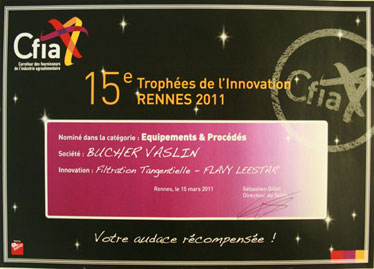

Bucher Winefiltration has attended for the 1st time the CFIA exhibition in Rennes/France in March 2011(exhibition dedicated to agro-food industries suppliers) and has got a special Nomination in the “Equipment and Processes” category.
Flavy Leestar has already got a Bronze Trophy at Vinitech 2010.
Flavy Leestar is a new solution for filtering tank bottoms by cross-flow filtration. The idea originally comes from the use of a cross-flow filter equipped with stainless steel, tubular membranes, in order to get a filtered wine, net, clear, full of aromas.
« Tank bottoms » represent approximately 2 to 3 % of the wine volume from a winery. Their filtration enables to get back the ¾ of them. Those membranes are specifically adapted to the filtration of « tank bottoms ». Long-lasting, hard-wearing, the latter tolerate viscous, abrasive fluids (like bentonite, activated charcoal…) as much as fluids containing a large amount of solids.
This innovation, dedicated to large wineries, wine traders and bottling companies, brings along true improvement in terms of quality, respect of the environment, safety and return on investment.
The main reason for large wineries, wine traders and bottling companies for not treating their « tank bottoms » is linked in the fact that the poor-quality wine extracted from them, is not considered as valuable. « Tank bottoms » are thus sent to the distillery or undergo some other specific treatments.
At the moment «Tank bottoms» are filtered through a vacuum rotating filter or a press filter. As a matter of fact, the earth used for the filtration (Kieselguhr) has first shown a problem of input to be managed, then a problem of application and then again a problem of treatment (of used earth). Moreover, the filtration of « tank bottoms » using a vacuum rotating filter generates heavy wine losses up to 40 %. The final turbidity, from 25 to 45 NTU, needs a new fining, then a new filtration. On a qualitative point of view, the filtration of « tank bottoms » by means of a vacuum rotating filter produces a filtrate that is often oxidized with a loss of alcohol.
Flavy Leestar is adapted to wineries, large wineries and wine traders generating approximately 3% of « tank bottoms ».
Qualitative added value of the permeate : From an organoleptic point of view, the clarifying of tank bottoms and free-oxidation permeate are essential, qualitative assets. The permeate is thus easily valorized as it is reintegrated into the initial filtered wine batch.
Valorization of the filtration retentate : The main interest in using cross-flow filtration is to uphold suspended matters that will be separated and valorized in a distillery for example. On the contrary, when using traditional filtration, those suspended matters are absorbed and retained within the Kieselguhr used earth.
Operating safety : The filtration device as it is proposed is simple and fully automated for a perfect operating safety. You only need to plug, set the requested program and leave the filtration to be achieved … over night and day. Its ergonomics and accessibility do not require a particular know-how in filtration – the process is open to every winery operator. The winery staff can be working on some other tasks as only a monitoring of the process in action is necessary.
Respect of the environment and safety of operators : The use of a cross-flow filter, free from any used filtration earth, and therefore without any treatment, is respectful of the environment. As there is no filtration earth (or silica dust), healthcare of operators is taken into better account.
Return on investment : Depending on the context, return on investment is very fast: from 2 to 3 years. Operating costs are reduced and can be divided by up to 7 compared to the traditional filtration. In addition, the long-lasting feature of the membranes is an undeniable, economical asset.